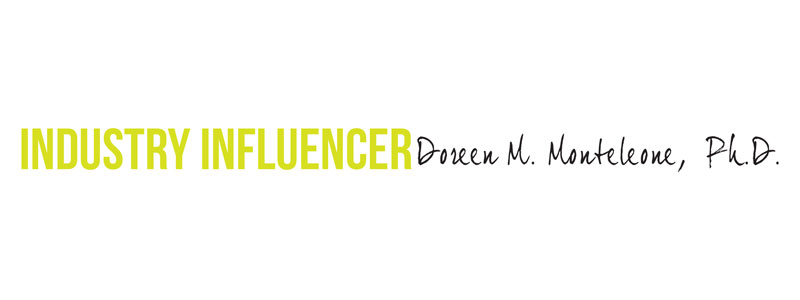
While it may be a hard connection for most of us to understand, Doreen M. Monteleone easily can explain how she went from receiving her Ph.D. in Coastal Oceanography to helping shape sustainability efforts in printing.
“My interests evolved, and jobs changed,” she said. “I went from marine research to Clean Water Act issues to Clean Air Act issues for small businesses to all environmental issues for flexographic printing – added health, safety and sustainability – and then tacked on UV technology.”
While Monteleone was working for Flexographic Technical Association (FTA), she was named New York State’s first Small Business Ombudsman, an opening created under the Clean Air Act Amendment of 1990. In that position, she worked with small businesses impacted by the new regulations adopted in New York.
“That included the printing industry. When the state administration changed, I also was seeking employment closer to home [she had become a new mom],” she said of her move 23 years ago. “I learned about FTA’s desire to hire a full-time environmental director to help its members. It was a natural fit.”
For the past six years, Monteleone has contracted with the FTA and RadTech International North America to address sustainability issues – a role PostPress finds influential in printing.
What inspired your interest and studies in sustainability?
I’ve always had a love of the environment. I also am a Master Gardener with Cornell Cooperative Extension of Suffolk County and am outside all the time. I want my descendants to live in a world that is in better shape than the one we live in now. I truly believe we can achieve that goal. We have much cleaner air, water and land than when I was a kid. Some people don’t realize that. But, we can continue to do better as we learn more sustainable techniques and develop better technologies. I feel that whether I give lectures on more sustainable gardening practices or on the benefits of more sustainable printing practices, I can help achieve that goal of a better future.
Tell us about SGP and why the accreditation was created?
About 12 or so years ago, Walmart came out with its Sustainability Packaging Scorecard for its vendors. That sent ripples through the manufacturing supply chain. We always hear about packaging and the impact of substrate. But, what is the packaging without the printing? Printing also is an important link in the supply chain. Printers turned to their trade and technical associations to answer the questions: ‘What is sustainability?’ and ‘How can I prove I am a sustainable printer?’ Our industry is fortunate in that the major printing associations have had a long, productive working relationship on environmental issues.
My counterparts – Marci Kinter, Specialty Graphic Imaging Association (SGIA), Gary Jones, SGIA (formerly with Printing Industries of America) and George Fuchs, National Association of Printing Ink Manufacturers (NAPIM) – and I had been working together for many years on a variety of environmental issues and joint conferences. But, now we needed to help our members and offer them a way to validate their sustainability efforts in a credible, transparent way.
The Sustainable Green Printing Partnership (SGP) was created out of several stakeholder meetings and a consensus that defined sustainable printing and established an independent certification program, not connected to any one association, but representing the entire industry. It was quite a learning process for all of us, and it brought us even closer as a group as we tackled all the elements of incorporation, board development, budgets, criteria development, databases, auditing process and on and on. We all had Environmental, Health and Safety (EHS) experience, but here we were creating an entire company and certification program from scratch. We now are approaching the 11th anniversary of SGP.
Can you discuss the steps a printer or finisher needs to take to become SGP certified?
The established criteria for SGP certification are available on the website: www.sgppartnership.org.
The criteria include best practices for printing and are specific to print processes as they were created by the printing industry for the printing industry. The criteria go well beyond a single attribute program like a paper certification and take a holistic approach. Everything from the office to the pressroom and finishing is included.
- Printers must be compliant with relevant environmental, health, safety and labor laws.
- They must implement the best practices in the criteria.
- They must set goals and track metrics.
- And, every two years, the printers must pass an audit by one of our very experienced SGP auditors.
SGP took a huge step last year and released the SGP Impact Tracker to help printers through and maintain certification. Printers log into a cloud-based dashboard where they upload their requirements and track metrics. So, for example, when they upload energy metrics, like kWh of electricity, they can track usage, normalize it based on several production options and determine trends. The Impact Tracker can illustrate this as a graph and compare it to tons of carbon emissions saved and equivalent trees planted. It’s a great tool to demonstrate performance to management, staff and customers.
How can being SGP certified create advantages for printers, finishers, binders and others in the industry?
SGP helps facilities in many ways. Going through the certification process helps facilities get organized and truly evaluate their entire operation. Over the years, many printers have claimed they were sustainable but didn’t realize they have been overlooking other aspects of their operations. SGP requires them to set goals, and this keeps them on track to make improvements every year and validate their sustainability efforts. It is the only certification program for the printing industry in the United States and Canada. By becoming SGP certified, printers have a competitive edge. SGP continues to gain support from print buyers who are seeking out a more sustainable print supply chain.
What changes or additions do you see SGP adding in the future?
Toward the end of 2019, SGP will come out with a draft certification program for suppliers. We’ve been asked about this for a number of years. Recently, Tag and Label Manufacturers Institute (TLMI) joined the SGP community as a SGP Resource Partner (that’s what we call associations and educators) and is helping by sharing the experience of the former L.I.F.E. certification for suppliers. We expect to release the criteria for suppliers in 2020. SGP also is exploring expansion outside of the United States and Canada and into Mexico.
What are your predictions for sustainable practices in the industry over the next five years?
Sustainability is here to stay, and there is no doubt about that. As much as I try to be sustainable and environmentally conscious, I see it as even more important to my sons. The industry has made many advancements since the Clean Air Act of 1990 and the announcement of the Walmart Packaging Scorecard years later. We should be proud of how far we have come.
I believe more print buyers will demand that their suppliers be sustainable and recognize SGP certification. More printers will become SGP certified as their customers demand it and their competitors get certified. More associations, like FSEA and RadTech, will join in SGP’s effort to spread the word about the benefits of sustainable printing and the certification program. There will be more advancements in the future, and no area of printing will be stagnant. There will be more sustainable inks, more efficient presses, better substrates, safer ways to print, etc.
And, why not? It’s simple – sustainable printing practices are just good business practices. It only makes sense to strive to become more sustainable.





